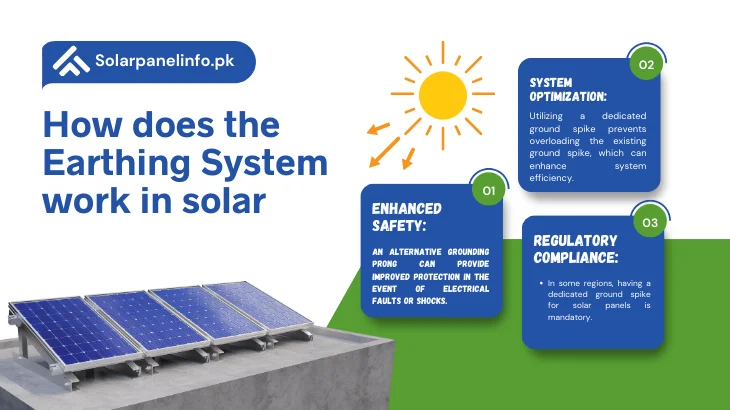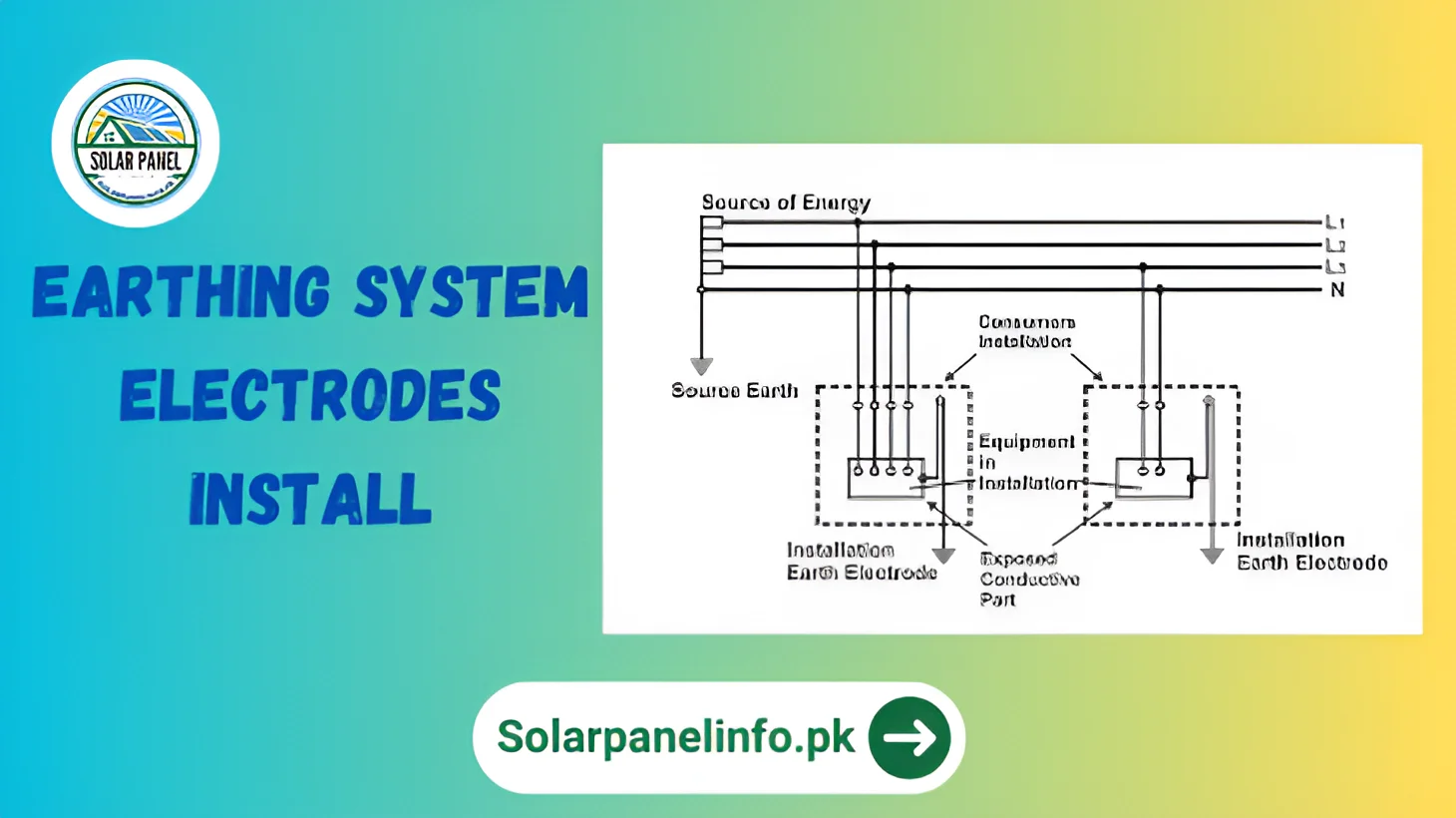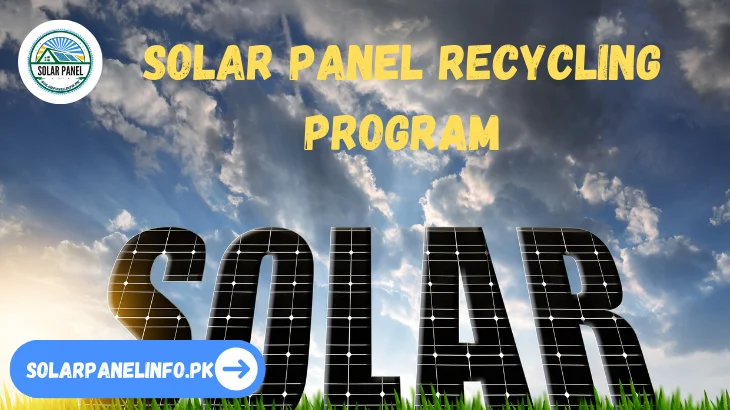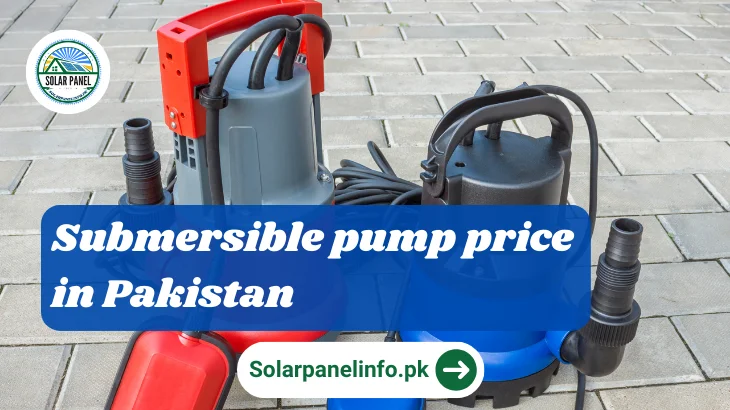How does the Earthing System work in solar
The text emphasises the significance of the earthing (grounding) system, which is sometimes disregarded in solar power installations. In addition to improving the overall performance and lifespan of solar energy systems, it highlights how important a well-designed earthing system is for the safety of both people and devices. To better understand how earthing systems work, this article will examine their types, importance, and best practices for solar energy installations. Here we will discuss How does the Earthing System work in solar.

متن میں ارتھنگ (گراؤنڈنگ) سسٹم کی اہمیت پر زور دیا گیا ہے، جسے کبھی کبھی شمسی توانائی کی تنصیبات میں نظر انداز کیا جاتا ہے۔ شمسی توانائی کے نظام کی مجموعی کارکردگی اور عمر کو بہتر بنانے کے علاوہ، یہ اس بات پر روشنی ڈالتا ہے کہ ایک اچھی طرح سے ڈیزائن کیا گیا ارتھنگ سسٹم لوگوں اور آلات دونوں کی حفاظت کے لیے کتنا اہم ہے۔ بہتر طور پر سمجھنے کے لیے کہ ارتھنگ سسٹم کیسے کام کرتے ہیں، یہ مضمون ان کی اقسام، اہمیت اور شمسی توانائی کی تنصیبات کے لیے بہترین طریقوں کا جائزہ لے گا۔
What is an Earthing System?
An earthing system, also called a grounding system, is a safety mechanism that connects electrical installations to the earth. It provides a low-resistance path for fault currents to safely dissipate into the ground, protecting both people and equipment from electric shocks, fires, and damage caused by electrical faults.
Earthing System Electrodes Installation
To install grounding electrodes, you typically need to dig holes or create ravines in the ground to securely place the electrodes.

It is important to ensure a strong connection between the electrodes and other metal parts of the solar charger system, such as mounting frames and equipment enclosures. This connection helps create a continuous grounding path.
Importance of Earthing in Solar Systems
Safety of Personnel and Equipment:(عملے اور سامان کی حفاظت)
Proper earthing is crucial as it directs leakage currents safely into the ground, significantly reducing the risk of electric shocks.
System Protection:(سسٹم کی حفاظت)
Effective earthing safeguards solar equipment—including inverters, panels, and other electrical components—against damage that may arise from electrical faults or lightning strikes.
Stability and Performance:(استحکام اور کارکردگی)
Implementing proper earthing helps minimize electrical noise, ensuring that the solar system operates at optimal efficiency.
Compliance:(تعمیل)
Most jurisdictions mandate adherence to national and international safety standards for earthing, making it a critical aspect of solar system installation and maintenance.
How Does the Earthing System Work in Solar?
In a solar power system, the earthing process is essential for safety and system stability. It involves connecting various components of the system to the ground. Here’s how it is typically implemented:
Earthing of Solar Panels:(سولر پینلز کی ارتھنگ)
The earthing conductor connects to the metal frames of solar panels and safely directs any leakage current or induced voltage to the ground. This connection protects both the panels and the overall system from potential damage.
Earthing of Inverter and Electrical Components:
Solar inverters play a crucial role by converting direct current (DC) generated by solar panels into alternating current (AC) electricity. To ensure safety and enhance system reliability, these inverters, along with distribution boards and other electrical components, are grounded. This grounding minimizes the risk of electrical faults.
Grounding Electrodes:(گراؤنڈنگ الیکٹروڈ)
To establish a reliable grounding system, copper rods, galvanized iron (GI) rods, or copper plates are often buried deep into the earth. These grounding electrodes allow fault currents to be safely dissipated into the ground, further enhancing system safety.
Lightning Protection System:(بجلی سے تحفظ کا نظام)
In larger solar installations, a lightning protection system is critical. Lightning arrestors can be installed to safeguard against lightning strikes, channeling the electrical discharge safely to the ground through a dedicated grounding system. Overall, proper earthing in a solar power system is vital for protecting equipment and ensuring safe operation.
Types of Earthing in Solar Systems
Equipment Earthing(سامان ارتھنگ)
It refers to the practice of grounding non-current carrying components of solar equipment, which typically includes elements like the panel frames and inverter casings. This grounding is essential for safety, as it helps prevent electrical shock or damage to the equipment.
System Earthing(سسٹم ارتھنگ)
It connects the electrical system, particularly the negative terminal of the DC side, directly to the ground. This connection is crucial for controlling transient voltages, which can occur due to factors such as lightning strikes or sudden changes in electrical load. By stabilizing these voltages, system earthing significantly enhances the overall stability and safety of the solar installation.
Functional Earthing(فنکشنل ارتھنگ)
It is tailored to the operational requirements of the solar system. It is designed to ensure that the system behaves appropriately during faults or fluctuations in power supply. This type of earthing plays a vital role in maintaining the safety and performance of the solar energy system under various operational conditions.
Best Practices for Solar Earthing
Utilize High-Quality Materials(اعلیٰ معیار کے مواد کا استعمال کریں)
It is essential to select corrosion-resistant materials, such as copper or galvanized iron, for grounding conductors and electrodes to ensure durability and effectiveness.
Conduct Regular Maintenance(باقاعدگی سے دیکھ بھال کریں)
To maintain optimal conductivity and integrity of the earthing system, it is important to perform periodic inspections and maintenance.
Adhere to Established Standards(قائم کردہ معیار پر عمل کریں)
Compliance with local and international standards, such as IEC 60364 and IEEE 80, is crucial for proper earthing and grounding practices.
Differentiate Lightning and Equipment Grounding(آسمانی بجلی اور آلات گراؤنڈنگ میں فرق کریں)
Establish distinct pathways for lightning protection and equipment grounding to safeguard sensitive components from potential damage caused by surges. This approach helps to mitigate risks and ensure the integrity of electrical systems.
Benefits of Using Your Solar Panels
- Enhanced safety: An alternative grounding prong can provide improved protection in the event of electrical faults or shocks.
- Regulatory compliance: In some regions, having a dedicated ground spike for solar panels is mandatory.
- System optimization: Utilizing a dedicated ground spike prevents overloading the existing ground spike, which can enhance system efficiency.
- Additional cost: Installing an extra ground spike can increase the overall installation expense.
- Space requirement: It necessitates additional space on the property, which can be inconvenient in smaller areas for maintenance and monitoring.
Read more: Lightning Arrester in Pakistan
What Are The Steps You Can Take?
The earthing system is a critical safety measure for any installation, even if it may seem complex at first glance.
Choose Qualified Professionals:(اہل پیشہ ور افراد کا انتخاب کریں)
Always hire highly trained and experienced installation experts. While it may be tempting to cut costs initially, investing in the proper installation of your photovoltaic (PV) system is essential for optimal performance, increased savings, and enhanced safety.
Schedule Regular Inspections:(باقاعدہ معائنہ کا شیڈول بنائیں)
Plan routine safety inspections to identify any potential issues before they escalate into significant problems.
By following these practices, you can ensure a safely operating earthing system that supports the overall efficiency of your installation.
Conclusion:
A well-designed and properly maintained earthing system is essential for ensuring the safety, stability, and efficiency of any solar power installation. It protects both personnel and equipment from electrical hazards by providing a safe path for fault currents. To achieve long-term system performance and comply with established standards, it’s important to follow best practices such as using high-quality materials and conducting regular maintenance. By prioritizing proper earthing, you can improve the reliability of your solar energy system while reducing the risk of electrical dangers.
کسی بھی شمسی توانائی کی تنصیب کی حفاظت، استحکام اور کارکردگی کو یقینی بنانے کے لیے ایک اچھی طرح سے ڈیزائن اور مناسب طریقے سے دیکھ بھال کرنے والا ارتھنگ سسٹم ضروری ہے۔ یہ فالٹ کرنٹ کے لیے محفوظ راستہ فراہم کر کے عملے اور آلات دونوں کو برقی خطرات سے بچاتا ہے۔ نظام کی طویل مدتی کارکردگی کو حاصل کرنے اور قائم کردہ معیارات کی تعمیل کرنے کے لیے، اعلیٰ معیار کے مواد کا استعمال اور باقاعدگی سے دیکھ بھال کرنے جیسے بہترین طریقوں پر عمل کرنا ضروری ہے۔ مناسب ارتھنگ کو ترجیح دے کر، آپ برقی خطرات کے خطرے کو کم کرتے ہوئے اپنے شمسی توانائی کے نظام کی وشوسنییتا کو بہتر بنا سکتے ہیں۔
FAQ’s
Why is earthing important in a solar power system?
Earthing is important to keep people and equipment safe from electrical shocks. It helps reduce electrical noise and prevents damage from faults or lightning strikes.
What materials are best for solar earthing systems?
Corrosion-resistant materials like copper and galvanized iron (GI) are ideal for grounding conductors and electrodes due to their durability and conductivity.\
How often should a solar earthing system be inspected?
Conduct regular inspections at least once a year to maintain the system’s integrity and detect potential issues early.


